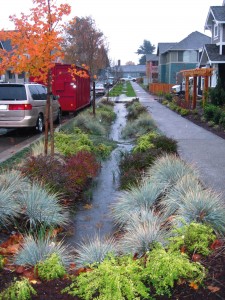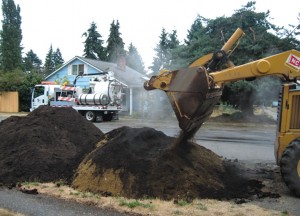The cities of Seattle, Washington and Portland, Oregon have been early leaders in using storm water management tools that incorporate compost.
David McDonald, Shanti Colwell and Henry Stevens
BioCycle March 2012, Vol. 53, No. 3, p. 39

The High Point Redevelopment Project in Seattle combined street-side bioretention swales with compost-amended soils over the entire site (34 city blocks). Performance of the bioretention swale filtering and infiltrating street runoff during a 100-year storm event is shown above.
Seattle, Washington (www.seattle.gov/util/greeninfrastructure) and Portland, Oregon (www.portlandonline.com/sustainablestormwater) have been leaders in piloting GSI methods, doing research to prove what works, and then adopting it into local codes, with support from Washington State Department of Ecology and Oregon Department of Environmental Quality. Other leaders include Prince George’s County, Maryland, where “low impact development” (another term for GSI) methods were first widely used in the 1990s, and more recently Philadelphia and a host of other cities discovering innovative ways to use green strategies to shore up aging gray (concrete) storm water systems. (See the USEPA’s www.epa.gov/owow/NPS/lid/ for many examples and resources.)
Compost is the tool of choice in green storm water strategies. Simple soil protection and restoration with compost best management practices (BMPs) were popularized by Washington’s Soils for Salmon project (www.soilsforsalmon.org) and are now incorporated into the national SITES™ www.sustainablesites.org) standards and numerous local codes. Urban forestry experts recognize the value of compost amendments in restoring functional soil conditions for trees in cities and industrially degraded sites. The USEPA promotes use of compost-based erosion control methods (compost blankets, berms, and socks) as part of federally-required construction site storm water management around the county. And bioretention swales and cells (aka “rain gardens”) are a key method for managing road and roof runoff. They rely on mixes comprised of one-quarter to one-third (by volume) mature, stable compost with a local sandy soil for rapid infiltration, excellent pollutant removal and vigorous plant growth.
Compost quality is critical for GSI success. Using up to one third compost in bioretention mixes, or amending tree pits or other valuable soils where plants will be used, requires compost that is mature, stable and optimal in terms of C:N, pH, salts, nutrients and microbiological profile. In the Pacific Northwest and elsewhere around the United States, most jurisdictions and design professionals are relying on compost that meets the US Composting Council’s STA (Seal of Testing Assurance) and TMECC test methods. Interactions of the compost with local soils are also critical. For example, too many fines will plug up a sandy bioretention soil mix, and turf planted on clay soils will need lower organic amendment rates than sandy soils. Compost manufacturers, marketers, specifiers and storm water design professionals need to become experts on which compost parameters are critical for their uses, as well as their local soil and plant conditions. Storm water systems are expensive, and regulations don’t allow failure, so just as in any new market it’s up to the compost industry to provide dependable materials and to educate end users for successful use.
Compost In GSI Applications
Two examples of compost use in green storm water infrastructure in Seattle and Portland include:
New and Redevelopment: The High Point Redevelopment Project in Seattle combined street-side bioretention swales with compost-amended soils over the entire site, which is comprised of 34 city blocks. Swales ranged from broad ditches to shallow grassy planting strips with a more conventional appearance. Residents and maintenance staff were educated about grasscycling, mulching and minimizing pesticide use to maintain long-term soil health and protect water quality. The city had challenges in getting construction subcontractors to implement soil protection and amendment practices; educating project managers and every contractor on site is essential for success.

Bioretention soils typically are comprised of one-quarter to one-third (by volume) mature, stable compost with a local sandy soil for rapid infiltration, pollutant removal and vigorous plant growth.
With each retrofit project, Portland and Seattle learn more about the importance of fitting bioretention designs to the site soil conditions and rainy-season hydrology, anticipated storm water flow volumes, and the local community’s needs for traffic-calming, pedestrian access, appearance and urban green.
Shanti Colwell is a Senior Civil Engineer and David McDonald is a Resource Conservation Planner at Seattle Public Utilities. Henry Stevens is an Environmental Specialist at the City of Portland’s Environmental Services. They have helped develop bioretention soil specifications and worked on many bioretention project installations. The authors are the instructors at the preconference workshop, Compost Use In Green Infrastructure, on April 16, 2012 at BioCycle’s West Coast Conference.
The tour portion of the preconference workshop begins at 3:15 pm. Participants will board a bus to tour street-side bioretention facilities in Portland. Questions and discussion will continue while in transport and at the green infrastructure installations. Workshop fee: $145. To register and for more information, visit www.BioCycleWestCoast.com.










